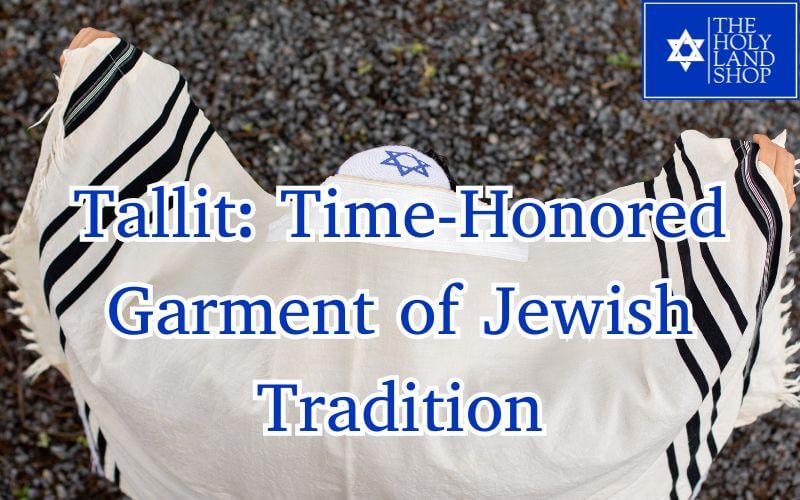The Tallit holds a special place in Jewish traditions. It is a prayer shawl, rich in symbolism and history. Worn during prayer, one is enveloped in spirituality. It connects the wearer with God and the essence of Jewish identity. Its threads weave through the fabric of Jewish life, from daily rituals to milestone celebrations.
It is not just a piece of fabric. It is a sacred garment, a mitzvah, and a link to the divine. Its significance is profound, accompanying individuals in their spiritual journey. By wrapping themselves in the Tallit, worshippers embrace a powerful Jewish tradition. This act becomes a personal space for connection and reflection in prayer.
This article will explore the Tallit’s background, components, and role in Judaism. It will guide readers through its historical origins, artistic aspects, and spiritual meanings. It will also offer insights for those looking to choose a Tallit as a meaningful expression of faith. Thus inviting readers to appreciate and connect with the rich traditions of the Tallit.

Historical Background
The Tallit has ancient roots, tracing back to the times of the Torah. Originally, it featured special tassels, tzitzit, on its corners. These tassels were a reminder of God’s commandments and presence. Over time, the Tallit has evolved, reflecting changes in fashion and local customs. Different Jewish communities have embraced various styles and traditions.
In some communities, the Tallit became larger and more enveloping. It transformed into a garment that could cover the person during prayer fully. The fabrics and colors used also varied. Different regions adopted materials that were locally available and suited their climates and needs. This resulted in a rich tapestry of designs and forms.
In addition to physical changes, the customs around wearing the Tallit also saw variations. In certain traditions, the Tallit is worn from a young age, while in others, it’s adorned after marriage. This diversity showcases the dynamic nature of this religious symbol. It illustrates how the Tallit has remained relevant, adapting to the changing times and communities.
Understanding the Tallit’s historical journey enriches its current significance. It allows us to appreciate the depth of meaning and tradition woven into its threads. Thus, the Tallit is not just a garment but a living testament to Jewish history and adaptability.
Components and Design
The Tallit is traditionally made of wool or silk. Its design is simple yet filled with symbolism. A series of stripes adorn the garment, typically in blue or black. These stripes have various interpretations, such as representing the different levels of heaven.
Another crucial component is the tzitzit, the fringes or tassels, attached to the Tallit’s corners. These fringes are knotted and twisted in a specific manner. They serve as a physical reminder of God’s commandments, enhancing the wearer’s spiritual awareness and dedication.
In terms of symbolism, each part of the Tallit holds significant meaning. The main section, or the “body,” represents the wearer’s personal space. It becomes a special zone for prayer and connection with the divine. The stripes, as stated, can symbolize the heavens, adding a celestial dimension to the prayer experience.
The tzitzit, too, embodies deep meanings. Their knots and windings are connected to the numerical value of God’s name. Through these elements, the Tallit becomes more than a prayer shawl. It transforms into a tool for meditation and spiritual exploration, enhancing the richness of the prayer experience. In its entirety, the Tallit’s design invites the wearer into a space of sanctity and divine presence, making each prayer session a unique spiritual journey.
The Craftsmanship of Tallit
Crafting a Tallit is an art steeped in tradition and spirituality. Different materials, like wool and silk, are commonly used, each bringing a unique feel and significance. Wool is most traditional, cherished for its warmth and durability. However, silk and other materials are also popular, allowing for variety and personal preference.
The techniques involved in making a Tallit are meticulous and symbolic. Precision is key, ensuring that every aspect, from the stripes to the tzitzit, is perfectly aligned and attached. This careful craftsmanship contributes to the Tallit’s sanctity and beauty.
Various unique designs and styles have emerged over time, allowing wearers to express individuality in their spiritual practice. Some Tallitot boast intricate patterns and embroidery, while others maintain a more simplistic elegance. The diversity in design ensures that each Tallit carries a personal touch, enhancing the connection between the garment and its wearer.
In every thread and pattern, the craftsmanship of the Tallit speaks volumes of its spiritual significance. The dedication and artistry involved in its making highlight the Tallit as not just a garment, but a cherished companion in one’s spiritual journey.
Wearing the Tallit: A Spiritual Ritual
Wearing a Tallit goes beyond a mere religious requirement; it’s a deeply spiritual ritual in Judaism. The act begins with a blessing, setting a tone of sanctity and connection. The Tallit is then draped over the shoulders, enveloping the wearer. This creates a personal space for prayer, enhancing focus and spirituality.
There are specific customs tied to wearing the Tallit. Typically, it is worn during morning prayers, known as Shacharit. It also adorns the worshiper during Torah readings, highlighting the sacredness of these moments. Furthermore, it plays a special role in various Jewish ceremonies, like weddings and Bar Mitzvahs.
When one wraps themselves in the Tallit, a transformation occurs. It’s not just about covering oneself with a prayer shawl. Instead, it symbolizes wrapping oneself in prayer and spirituality. It becomes a tool, helping the wearer connect deeply with God.
In conclusion, the Tallit is not merely a garment. Wearing it is a profound ritual, rich in symbolism and spirituality. It serves as a spiritual guide, navigating the wearer through the journey of prayer and connection with the divine.
Tallit Gadol and Tallit Katan: Understanding the Distinctions
The Jewish tradition features two primary types of Tallit – the Tallit Gadol and the Tallit Katan. Each has unique characteristics, usage, and significance. The Tallit Gadol is the larger shawl-like garment, commonly used during morning prayers. It is often introduced to a child during their Bar Mitzvah, signifying their religious maturity.
In contrast, the Tallit Katan is a smaller garment, typically worn daily. It serves as a constant reminder of God’s commandments, woven subtly into the rhythms of everyday life. Unlike the Tallit Gadol, it’s usually worn under clothing, making it less visible but continually present.
Understanding the distinctions between these two forms of Tallit is essential. It helps in appreciating their specific roles in Jewish life and spiritual practices. Both, though different in size and use, serve as powerful, tangible symbols of faith and devotion. Together, they allow individuals to embody their commitment to Jewish traditions in varied yet equally meaningful ways.
The Tallit in Life Milestones
The Tallit holds a special place in marking Jewish life milestones. It carries a powerful symbolism, making events like Bar/Bat Mitzvahs and weddings even more poignant. In a Bar Mitzvah, the celebration of a boy’s religious coming-of-age, it plays a central role. It signifies the boy’s entrance into the realm of religious adulthood.
For weddings, the Tallit is also profoundly significant. Often, it is used to create the Chuppah, or wedding canopy, symbolizing the couple’s new home. It represents a divine presence and blessing over the marital union, adding depth to the ceremony. In some customs, the groom may also wear the Tallit during the ceremony, signifying the acceptance of religious responsibilities.
In addition to these, the Tallit can also be present in other life milestones. It may be used in naming ceremonies, conversions, and even at funerals. It acts as a symbol of God’s presence and the community’s shared faith, adding sanctity to these essential life moments.
In every use, it is more than a ritual object. It becomes a witness to life’s most significant moments, threading continuity through a person’s life journey. Its presence speaks of tradition, faith, and the profound spirituality woven into the fabric of Jewish life.
Tallit in Contemporary Judaism
Designs have seen many changes in contemporary times. Today, we find a blend of tradition and modernity. Various materials, colors, and patterns are now available, making each Tallit unique. Some prefer the classic black and white stripes, while others lean towards vibrant colors and creative designs. Customization allows wearers to express their personal faith journey.
Beyond design, the way people use the Tallit has also evolved. While still prominent in synagogues, many now wear it during personal prayer times at home. It’s not just for special occasions. Everyday use underscores its deep spiritual importance.
Gender roles in Tallit use are shifting, too. Traditionally worn by men, many women in Reform and Conservative communities now embrace the Tallit. This change highlights a broader move towards inclusivity in modern Jewish practice.
Younger generations also bring their perspectives. They value the Tallit’s rich history but adapt its use to resonate with their lives. For many, it’s a bridge between the past and their current faith journey.
In essence, this remains a powerful Jewish symbol. Despite changes and adaptations, its core purpose stays the same. It connects wearers to God, their heritage, and the wider Jewish community. In today’s diverse and evolving world, the Tallit stands firm as a touchstone of Jewish identity and expression.
Purchasing a Tallit
When buying a Tallit, several factors deserve consideration. First, consider the material. Wool, silk, and cotton are common, each offering a different look and feel. Wool is traditional and widely accepted in various Jewish communities.
Next, reflect on design and color. Classic Tallitot are white with blue or black stripes. Modern ones explore various colors and patterns. Choose a design that resonates with your sense of spirituality and aesthetics.
Size is another essential aspect. Some Tallitot are large, enveloping the body, while others are smaller and simpler. Consider your comfort and the customs of your community in this choice.
Additionally, consider the Tzitzit, the fringes, or tassels. They should be tied correctly and made of kosher materials. The Tzitzit are a vital part, imbued with significant spiritual symbolism.
Consider also the Atarah, the neckband. It often contains embroidered blessings or decorations, adding beauty and meaning to the Tallit.
Before purchasing, it’s advisable to research the seller’s credibility. Ensure they are reputable and offer authentic, kosher Tallitot. Consulting with a rabbi or knowledgeable person in Jewish laws and customs can provide valuable guidance.
In conclusion, this choice is a personal journey. It involves navigating tradition, community customs, and individual preferences. The goal is to find a Tallit that becomes a cherished part of your spiritual practice.
Conclusion
The Tallit holds enduring significance in Jewish life and faith. It bridges the ancient traditions with our contemporary experiences, ensuring the continuance of rich, spiritual customs. Wearing a Tallit becomes a personal practice, deeply woven with threads of tradition and modern relevance.
Furthermore, the Tallit isn’t just a garment. It carries weighty symbols and meanings, nurturing Jewish identity. It remains a strong connector to faith, enabling wearers to wrap themselves in a fabric of prayer and tradition.
In embracing the Tallit, individuals find a path to explore and deepen their spiritual journey. It provides a tangible way to connect, pray, and uphold Jewish customs and laws. This essential piece cultivates a rich, tactile connection to Jewish traditions and rituals.
For those seeking to own a Tallit, there’s valuable assistance available. It’s possible to find authentic, beautiful Tallitot directly from Israel. Help is at hand to guide you through the selection and purchasing process. This guidance ensures that you can find something that resonates with your personal spirituality while maintaining traditional authenticity.
In conclusion, the Tallit remains a vibrant part of Jewish tradition. It invites everyone to engage with their faith in a deeply personal manner. By selecting and wearing one, you continue a beautiful legacy of faith, prayer, and tradition. Explore, embrace, and enhance your spiritual journey. Assistance is available to help find the perfect Tallit from the holy land of Israel.
